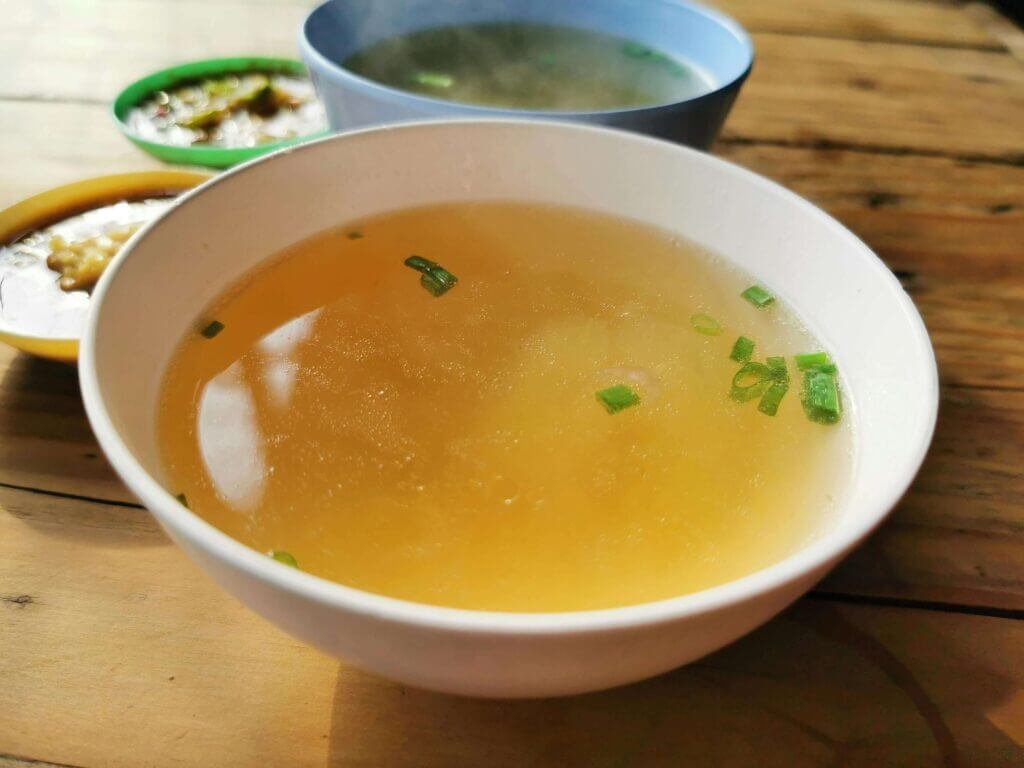Disclaimer: This post contains affiliate links, including links to Amazon. As an Amazon Associate, we earn from qualifying purchases at no additional cost to you. Thank you for supporting Low Tox & Thrive!
Bone broth is an incredibly nourishing staple for anyone seeking to incorporate more natural, wholesome foods in their diet. This comforting, nutrient-dense liquid has been used for centuries as a remedy for everything from digestive health to immune support.
And by making bone broth at home, you have the added benefit of full control over the ingredients, ensuring a broth free of preservatives and additives, while packing it with healing nutrients. The best part? It’s surprisingly simple to make.
In this article, we’ll cover easy-to-follow bone broth recipes and answer some frequently asked questions to help you master the art of broth-making.
Benefits of bone broth
Bone broth offers a wide range of health benefits, including:
- Supports gut health: Bone broth is packed with gelatin, which helps repair the lining of the gut and improves digestion. It’s especially beneficial for those with leaky gut or digestive issues.
- Boosts joint health: The collagen and amino acids (like glycine and proline) in bone broth help support healthy joints, reducing inflammation and improving mobility over time.
- Enhances skin and hair: Collagen is also great for your skin, hair, and nails. Regular consumption of bone broth can promote skin elasticity and strengthen hair and nails.
- Rich in minerals: Bone broth contains essential minerals like calcium, magnesium, and phosphorus, which support bone health and overall vitality.
- Strengthens the immune system: The combination of amino acids and minerals can support your immune system, making bone broth a solid addition to your diet during cold and flu season.
- Aids in detoxification: The glycine in bone broth supports the liver’s detoxification process, helping your body to eliminate toxins more effectively.
How to consume bone broth
Here are some simple ways to incorporate bone broth into your routine:
- Sip it as a drink: Warm up a mug of bone broth in the morning or afternoon for a soothing, nourishing snack. It’s a great alternative to coffee or tea, especially when you’re craving something comforting (and without the caffeine crash).
- Use it in soups and stews: Bone broth adds a rich, flavorful base to soups, stews, and chilis. Swap it for water or store-bought broth in your favorite recipes.
- Cook grains or legumes with it: Use bone broth instead of water when cooking grains like rice, quinoa, or lentils. This adds flavor and boosts the nutrient content of your meals.
- Make sauces and gravies: Bone broth can serve as a base for sauces, gravies, and reductions, adding depth and richness to your dishes.
- Freeze it for later: If you make a large batch of bone broth, freeze it in portion-sized containers or ice cube trays for easy access later. Simply thaw what you need and add it to your cooking.
How to make bone broth at home
Below, you’ll find two simple recipes to help you get started—one for beef bone broth and another for chicken bone broth. Both are packed with benefits and can be tailored to your taste.
Beef bone broth recipe
Ingredients:
- 4 lbs beef bones (marrow bones, knuckles, and joints)
- 2 carrots, roughly chopped
- 2 celery stalks, roughly chopped
- 1 onion, quartered
- 3 cloves garlic, smashed
- 2 tbsp apple cider vinegar
- 2 bay leaves
- 10-12 peppercorns
- Water to cover
Instructions:
- Preheat the oven to 400°F and roast the beef bones for 30-40 minutes for added depth of flavor.
- Transfer the bones to a stockpot or slow cooker with the vegetables, vinegar, bay leaves, and peppercorns. Cover with water, ensuring the bones are submerged about 2 inches.
- Simmer for 12-24 hours. Check on it every now and then to skim any foam from the top.
- Strain the broth and store in airtight containers. Refrigerate for up to 5 days, or freeze for up to 3 months.
Chicken bone broth recipe
Ingredients:
- 2-3 lbs of chicken bones (preferably from an organic, pasture-raised chicken)
- 2 carrots, roughly chopped
- 2 celery stalks, roughly chopped
- 1 onion, quartered
- 2 tbsp apple cider vinegar
- 2 bay leaves
- 10-12 peppercorns
- Water to cover
Instructions:
- Add chicken bones to a large stockpot or slow cooker along with the vegetables, bay leaves, peppercorns, and apple cider vinegar.
- Cover with water, ensuring the bones are submerged by about 2 inches.
- Bring to a boil, then reduce the heat and simmer for 12-24 hours. The longer you simmer, the richer and more gelatinous the broth will become.
- Strain through a fine mesh sieve, discard the solids, and store the broth in airtight containers. Refrigerate for up to 5 days, or freeze for up to 3 months.
Frequently asked questions about bone broth
Bone broth vs stock: What’s the difference?
The difference between bone broth and stock mainly lies in the cooking time and nutritional content. Stock is typically simmered for 2-6 hours using bones, some meat, and vegetables, resulting in a flavorful liquid used in cooking. Bone broth, on the other hand, is simmered for 12-24 hours, allowing more collagen, gelatin, and minerals to be extracted from the bones and connective tissue. This longer cooking process makes bone broth thicker, more nutrient-dense, and often consumed for its health benefits.
What are the best bones to use?
Chicken feet, wings, and carcasses are excellent for chicken broth due to their high collagen content. For beef broth, opt for marrow bones, knuckles, and joints to get the most gelatin and nutrient density.
Do I have to use organic bones for broth?
While it’s not required, using organic, grass-fed bones ensures you avoid antibiotics, hormones, and other contaminants that can be found in conventionally-raised animals. Organic bones also provide cleaner and more nutrient-dense broth.
Can I add herbs or spices to my broth for extra flavor?
Yes! Adding herbs like thyme, rosemary, or parsley can boost the flavor of your broth. You can also experiment with spices like turmeric, ginger, or garlic for an anti-inflammatory boost.
What is the purpose of vinegar in bone broth?
Vinegar, particularly apple cider vinegar, is added to many bone broth recipes to help extract minerals from the bones during cooking. The acidity of the vinegar breaks down the collagen and helps release essential nutrients into the broth, resulting in a more nutrient-dense final product.
How long do I need to cook bone broth for?
For a rich, gelatinous broth, simmering for 12-24 hours is ideal. The long cooking time helps extract the maximum nutrients from the bones, especially collagen and minerals. However, if you’re in a rush, even 8 hours will provide a nutritious broth.
Should I throw away the fat?
Totally up to you. Skimming the fat will give you a leaner broth, but the fat is full of nutrients and flavor. Many people save it to use for cooking, particularly beef tallow, which is great for roasting vegetables or frying.
How long does bone broth last in the fridge?
Bone broth can last in the fridge for about 5 days. If you don’t plan on using it within that time, freeze it to enjoy later.
How long does bone broth last in the freezer?
Bone broth can be frozen for up to 3 months. Freezing it in smaller portions or using an ice cube tray can make it more convenient for quick use.
What if I don’t have a crockpot or slow cooker?
You can also make these bone broth recipes in a regular stockpot on the stove. Just be sure to keep the heat low and simmer gently for 12-24 hours. Alternatively, an Instant Pot can create a rich broth in much less time.
When is the best time to consume broth?
Bone broth can be enjoyed anytime, but many people drink it first thing in the morning for a nourishing start to the day. It’s also great before meals to help aid digestion.
Add bone broth to your wellness regimen
Packed with health benefits like supporting gut health, joint function, and boosting your immune system, bone broth is a versatile and nourishing addition to your low tox routine. By making these bone broth recipes at home, you have complete control over the ingredients, ensuring it’s free of unwanted additives. Plus, it’s an easy way to reduce waste by using up bones that might otherwise be discarded.







